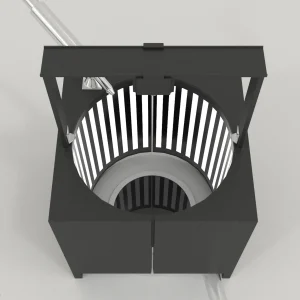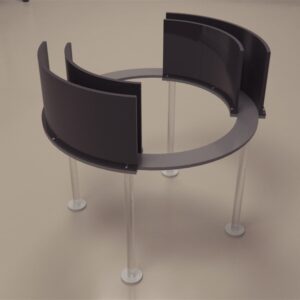$1,990.00
The Drosophila Gravitaxis Maze serves as a tool for observing the gravitaxis movement, whether positive or negative, in various Drosophila species. This maze, designed as a choice maze, permits subjects to move either upward or downward based on their inclination.
Constructed from polypropylene tubes, the maze comprises an entrance tube along with T and Y shaped connectors, facilitating the movement of flies. With one entrance and nine exits, the maze incorporates an attractant in the exit collection tubes alongside a light source positioned near the maze’s exit.
Drosophila navigate through the maze by selecting either an upward or downward path to reach their preferred exit. The frequency of up or down choices made by the flies is analyzed to infer their gravitaxis behavior.
Mazeengineers provides the Drosophila Gravitaxis Maze for research purposes.

MazeEngineers empowers preclinical neuroscience research with meticulously designed, customizable behavioral apparatuses. From manual classic mazes to fully automated smart systems, we provide the tools scientists need to capture high-quality, reproducible data for studies on learning, memory, anxiety, and depression.

bool(false)


Features |
Length of tube at maze entrance: 11cm |
Diameter of polypropylene tubing: 4.76mm |
Volume of exit tubes: 15ml |
Thickness of supporting base: 0.79mm |

The Drosophila Gravitaxis Maze serves as a tool for observing the directional movement, whether positive or negative, in various Drosophila species in response to gravity. Functioning as a choice maze, it grants subjects the option to move either upward or downward based on their preference. Results obtained from the gravitaxis maze are analyzed to explore the molecular and genetic underpinnings of gravitaxis.
Gravitaxis, also referred to as geotaxis, encompasses the directed movement exhibited by organisms in reaction to gravity. This gravitational response aids organisms in orienting themselves within their environment, a crucial aspect for survival. It is essential for organisms to react to gravitational forces either positively, moving towards gravity (geopositive response), or negatively, moving against gravity (geonegative response). Drosophila melanogaster, like other organisms, displays pronounced gravitaxis behavior.
Constructed from polypropylene tubes, the Drosophila gravitaxis maze features an entrance tube integrated into the maze structure, alongside T and Y shaped connectors. With one entrance and nine exits, the maze incorporates attractants in the exit collection tubes, complemented by a light source positioned near the exit. This setup enables Drosophila to navigate the maze by selecting either an upward or downward path to reach their preferred exit. The frequency of upward or downward choices made by the flies is analyzed to infer their gravitaxis behavior.
Other apparatuses utilizing the Drosophila model include the Drosophila Y Maze, the Drosophila Shallow Chamber, the Drosophila Maze Array, and the Drosophila Olfactory Operant Conditioning.
The gravitaxis maze comprises an entrance tube, the maze structure, and exit collection tubes. The entrance channel features an 11 cm long plastic tube covered with opaque black tape to provide a controlled entry point. Constructed from 4.76 mm diameter polypropylene tubing, the maze incorporates transparent plastic Y and T shaped connectors to facilitate navigation. Nine exit areas are established using 15 ml collection tubes made of acrylic, fitted through small plastic pipes and rubber stoppers. These tubes contain attractants for flies, such as yeast. To ensure stability, the maze is affixed to a supporting base measuring 0.79 mm in thickness. An illuminated source is positioned seven inches away from the collection tubes at the end of the maze for visibility and orientation.
Before commencing the trial, assign numbers to the collection tubes from top to bottom, labeling them as 1 to 9 to facilitate result calculation. For observing the flies’ gravitaxis behavior, an external tracking and recording system like Noldus Ethovision XT can be utilized alongside the Gravitaxis maze.
To prevent any transfer of food or debris into the gravitaxis maze, transfer the subjects into empty vials 20 to 30 minutes prior to loading them into the maze.
Fill the collection tubes at the maze exit with an attractant like yeast paste. Transfer the flies into the entrance tube and connect it to the maze entrance. After 1 hour, gently flick the entrance tube to encourage the flies to exit and enter the maze. Allow the flies to navigate through the maze towards the collection tubes, attracted by the nearby light source. After 3 hours, carefully remove the collection tubes and seal them with cotton plugs. Count the number of flies present in each collection tube.
Desroches, Busto, Riedl, Mackay, and Sokolowski (2010) conducted Quantitative Trait Locus (QTL) mapping using 88 recombinant inbred (RI) lines of male Drosophila melanogaster. To identify significant QTLs associated with gravitaxis behavior, they employed the Gravitaxis maze. Subjects underwent testing daily for five consecutive days, with maze location and strain randomized each day. Behavioral variability was observed across all RI lines in adult gravitaxis, with the mean exit tube position averaging approximately 4 across all Drosophila melanogaster lines. QTL mapping identified four significant gravitaxis QTLs located on the second and third chromosomes. Among these QTLs, gravitaxis QTL A exhibited the highest level of significance in the QTL analysis.
The Drosophila Gravitaxis maze allows for the recording of various parameters, including:
The gravitaxis maze is a valuable tool for evaluating gravitaxis behavior and provides fundamental data essential for assessing the molecular, cellular, and genetic aspects of this behavior in flies. Featuring a straightforward yet efficient design, the maze facilitates the assessment of gravitaxis behaviors effectively. It is user-friendly and yields consistent and replicable results. Subjects can be tested without the need for prior habituation to the apparatus.
The orientation (vertical or horizontal) of the maze plays a critical role in obtaining unbiased and precise results. Vertically oriented gravitaxis mazes tend to yield more accurate outcomes, as a larger number of flies tend to gather at the exit points. Conversely, horizontally oriented mazes often result in more random movements towards the right or left directions rather than towards or away from gravity (Armstrong, Texada, Munjaal, Baker, & Beckingham, 2006). Various factors such as age, sex, species, and strains can also influence the task results. Additionally, the presence of unnecessary disturbances and stimuli can impact task performances.
There are no questions yet. Be the first to ask a question about this product.